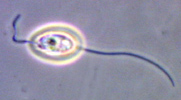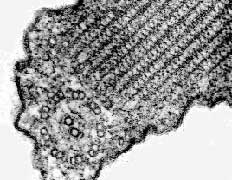The flagellates are a grade of organisation. Traditionally, they are those protozoa which spend most of their existence moving or feeding with a small number of flagella. This type of organization is the most widespread among protists. Of the 60 lineages of protists identified among the eukaryotes, 27 satisfy the condition of being a protozoan flagellate. In addition, alveolates and stramenopiles include heterotrophic flagellates, as do several groups often thought of as algae (dinoflagellates, euglenids, and cryptomonads). Some of the amoebae revert to flagellated forms for part of their life history or have non-functional flagella attached to their bodies.
Many parasites which affect human health or economy are flagellates. They include the relatively benign Giardia and the more damaging trypanosomes and leishmaniases. Flagellates are the major consumers of primary and secondary production in aquatic ecosystems - consuming bacteria and other protists and ensuring the recycling of limiting nutrients.


A variety of marine flagellates from the genera (left
to right) Cryptaulax, Abollifer, Bodo, Rhynchomonas, Kittoksia, Allas,
and Metromonas.
Drawings by Naja Voers.
Flagella arose early in eukaryote evolution, and we are not able to identify any groups of protists which are primitively without flagella.
Eukaryotic flagella are not the same as flagella of bacteria. They have an internal structure comprised of nine doublets of microtubules forming a cylinder around a central pair of microtubules. The peripheral doublets are linked to each other by proteins. These proteins include dynein, a molecular motor which can cause flagella to bend and propel the cell relative to its environment, or propel water or mucus relative to the cell. Many protists have embellishments within or on the outer surface of the flagellum (see electron-micrographs below ). There may be one, two or many flagella. Flagella in rows are said to occur in kineties. Cilia of ciliates and metazoa are a special type of flagellum, organized such that many flagella in kineties (= cilia) may work in synchrony.


Ploeotia (Euglenozoa, Euglenida, a heterotrophic euglenid common in marine sediments, showing anterior (to the left) and posterior flagella. Flagella in euglenids are thicker than in many other eukaryotes because of the presence of an additional rod within the flagellum (the crystalline structure within the flagellum to the right below), and because there is a thick coating of fine hairs on the outside.
Electron micrographs of Chilomastix cuspidata (excavates, retortamonads) and of Entosiphon sulcatum (Euglenozoa, Euglenida). The "9+2" axoneme and the enclosing membrane can be seen in both micrographs, the flagellum of Chilomastix has two vanes, and that of Entosiphon has a crystalline structure lying alongside the axoneme.
The flagellated body form is the most widely exploited among the eukaryotes. The tables below summarise the diversity of HETEROTROPHIC flagellates, and further flagellated taxa are encountered in some of the algal groups
Groups of Flagellates
| GROUP | CIRCUMSCRIPTION - EXAMPLES | HABITAT OF FREE-LIVING SPECIES | FOOD OF FREE-LIVING SPECIES | PARASITE? |
|---|---|---|---|---|
| Ancyromonas | genus of heterotrophic flagellates | marine, freshwater and terrestrial | bacteria | free-living |
| Apusomonads | several genera of heterotrophic flagellates, Apusomonas, Amastigomonas | marine, freshwater and terrestrial | bacteria | free-living |
| Cercomonads | several genera of heterotrophic flagellates, Cercomonas, Heteromita, Massisteria | marine, freshwater and terrestrial | bacteria | free-living |
| Collodictyon | genus of heterotrophic flagellates | free-living | protists | free-living |
| Cryothecomonas | genus of heterotrophic flagellates | marine | bacteria? | free-living |
| Dimorphids | several genera of heliozoon-like flagellates, Dimorpha, Tetradimorpha | marine, freshwater | bacteria | free-living |
| Diphylleia | genus of heterotrophic flagellates | freshwater | protists | free-living |
| Discocelis | genus of heterotrophic flagellates | marine | osmotrophic, bacteria | free-living |
| Ebriids | several genera of heterotrophic flagellates, ebria, Hermesinum | marine | protists | free-living |
| Excavates | flagellates, diplomonads, jakobids, retortamonads, Trimastix, Carpedediemonas, heterolobosea, etc. | marine, freshwater, terrestrial | bacteria | free-living and parasites |
| Euglenozoa | flagellates, euglenids and kinetoplastids, Peranema, Bodo | marine, freshwater, terrestrial | bacteria, protists, detritus | free-living, a few parasites |
| Hamates | Caecitellus and psedodendromonads (Pseudodendromonas, Cyathomonas), related to stramenopiles | marine, freshwater | bacteria | free-living |
| Kathablepharids | several genera of heterotrophic flagellates | marine, freshwater | bacteria, protists | free-living |
| Ministeria | genus of heterotrophic flagellates | marine | osmotrophic, bacteria | free-living |
| Multicilia | genus of heterotrophic flagellates | marine and freshwater | bacteria, protists | free-living |
| Oxymonads | several genera of heterotrophic flagellates, Oxymonas | endobionts | ||
| Parabasalids | several genera of parasitic heterotrophic flagellate, Trichomonas | free-living taxa in marine, soils and freshwater habitats | mostly endobionts, but a few free-living | |
| Pelobionts | several genera of amitochondriate flagellates | marine, freshwater, soils | osmotrophic, bacteria, detritus | free-living, a few parasites |
| Phalansterium | genus of heterotrophic flagellates | freshwater | bacteria | free-living |
| Plasmodiophorids | parasitic flagellates | freshwater, soils | pathogenic | |
| Spironemids | several genera of heterotrophic flagellates, Spironema, Hemimastix, Stereonema | freshwater, soils | bacteria | free-living |
| Spongomonads | several genera of heterotrophic flagellates, Spongomonas, Rhipidodendron | freshwater, soils | bacteria | free-living |
| Stephanopogon | genus of heterotrophic flagellates | marine | bacteria, detritus, protists | free-living |
| Telonema | genus of heterotrophic flagellates | marine | protists | predatory |
| Thaumatomonads | several genera of heterotrophic flagellates, Thaumatomastix, Protaspis | freshwater, marine, soils | bacteria, detritus, protists | free-living |
| Alveolates | heterotrophic dinoflagellates Colpodella |
freshwater and marine | bacteria, other protists | free-living, parasitic and syymbiotic |
| Cryptomonads | Goniomonas and Chilomonas | freshwater, soils and marine | bacteria, osmotrophs | free-living only |
| Opisthokonts | Choanoflagellates | freshwater, soils, marine | bacteria | free-living only |
| Stramenopiles | bicosoecids, proteromonads, opalines, heterotrophic chrysophytes, pedinellids | freshwater and marine | bacteria, osmotrophs | free-living and parasitic |
| Viridaeplantae | Polytoma, Polytomella and a few other genera | freshwater | osmotrophs | free-living |
Genera of flagellates for which ultrastructural studies have yet to be carried out, and whose ultrastructural identity is therefore still unknown (after Patterson, 1999)
|
|
|
|
|






 Go to quick links
Go to quick search
Go to navigation for this section of the ToL site
Go to detailed links for the ToL site
Go to quick links
Go to quick search
Go to navigation for this section of the ToL site
Go to detailed links for the ToL site